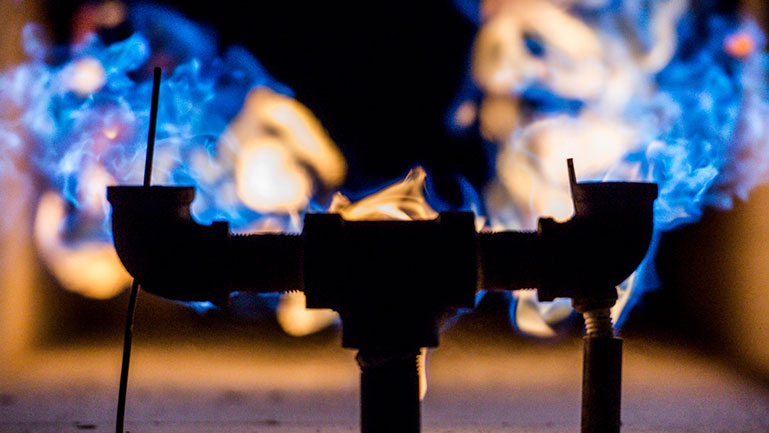Most buildings have specific requirements for the surface burning characteristics of the materials used in construction. These requirements are typically in place to help ensure that building occupants have enough time to safely vacate the building in the event of a fire. One of the most common requirements pertaining to the surface burning characteristics of mechanical insulation is what’s referred to as the flame spread/smoke developed. This test is a comparative test that is designed to evaluate the how quickly the tested material ignites and how much smoke is developed (smoke density) while it burns when compared to specific reference materials.
The test used to establish the surface burning characteristics of a material is ASTM E84: Standard Test Method for Surface Burning Characteristics of Building Materials (this test is interchangeable with UL 723: Standard for Test for Surface Burning Characteristics of Building Materials). This test is used to evaluate materials in the ceiling configuration with an exposed face to the ignition source. In commercial mechanical insulation applications, the requirement we see most often is for the ASTM E84 test is < 25 flame spread and < 50 smoke developed (typically referred to as 25/50).
It is important to note that ASTM E84 is used to measure and describe the response of materials, products, or assemblies to heat and flame under controlled conditions and so does not by itself incorporate all factors required for fire-hazard or fire-risk assessment. Nor does it predict the performance of the materials, products, or assemblies under actual fire conditions.1
The industry has established that materials that fall within the 25/50 indices pose an acceptable level of risk for most occupied building applications. Materials that rate in higher indices during the ASTM E84 test are often deemed too great a risk to be left exposed to occupied spaces and are typically permissible only for use in outdoor or protected applications.
In reviewing ASTM E84 test results, it’s important to understand that the results represent relative performance not exact or absolute numbers. The results refer to the performance of the materials compared to three different calibration materials:
1. The first calibration material is cement board. Cement board has a flame spread of 0 and a smoke developed of 0. Essentially, this is a material that does not contribute to flames or smoke.
2. The second calibration material is Red Oak, and it has a flame spread of 100.
3. The third calibration material is Heptane, with a smoke density rating of 100.
The calibration materials are used for two purposes. First, to ensure the equipment variables in the test are calibrated appropriately and consistently. In the case of the red oak control used for calibration, the flames must spread 19.5 feet in 5 ½ minutes (± 15 seconds), which results in the defined flame spread of 100. This helps researchers ensure that all materials are being tested under the same conditions. The second purpose for the calibration materials is to offer a comparative control for test materials.
During the test, a material is placed in a 25-foot, metal, refractory brick-lined tunnel, called a Steiner Tunnel. It is then exposed to calibrated flames for 10 minutes. The test produces a curve (flame spread x time) that researchers can use to calculate the comparative performance of test material against red oak. Since we know how quickly the flames spread on the red oak, this can help establish how a material might contribute to the spread of an actual fire; however the reported flame spread values of the tested materials aren’t necessarily linearly related to the red oak value.
It’s also worth noting that there is no correlation between the flame spread and the smoke density. A material could ignite and spread quickly, while still producing very little smoke, or it could burn slowly while producing a significant amount of smoke. The two measures are unrelated.
When measuring smoke density, the test evaluates how much light penetrates through the smoke while the material burns over the 10-minute test. The smoke values are plotted and the area under the curve during the entire test is used to determine the smoke-developed index. During calibration for the smoke density test, heptane and cement board have been assigned the smoke developed index of 100 and 0 respectively. A material with a smoke developed index of < 50 will produce 50% less smoke than heptane.
This ASTM E84 test is especially important when it comes to establishing which materials can be used in plenum spaces. Plenums are oxygen-rich environments that often house ducts, pipes, and electrical systems. If a fire were to break out in a plenum space, it could easily pump smoke throughout the building because of the duct system, and it also has the potential grow rapidly because of the oxygen excess. As a result, plenums have particularly stringent requirements about the types of materials that can be used.
This becomes tremendously relevant when we look at the growing trend in in mechanical applications toward using PVC and PP-R pipes, which are combustible, instead of incombustible metal pipes. PVC and PP-R are lighter, easier to install, and less expensive than metal pipes, making them an appealing alternative for some applications. Since these pipes are becoming more common, the international mechanical code calls for all combustible pipes to be covered with a 25/50 listed and labeled ASTM E84 material.
Join us for our webinar, Insulating Combustible Pipes in Plenums, on April 21, 2021 at 2:00 PM ET to learn more about the precautions you need to take for insulating combustible pipes in plenums.
To learn more about specifying materials that meet fire ratings without sacrificing system performance, watch our
on-demand Insulation Intel® Webinar: Insulating Combustible Pipes in Plenums on the Source.
Sources: https://www.astm.org/Standards/E84.htm, Section 1.8

